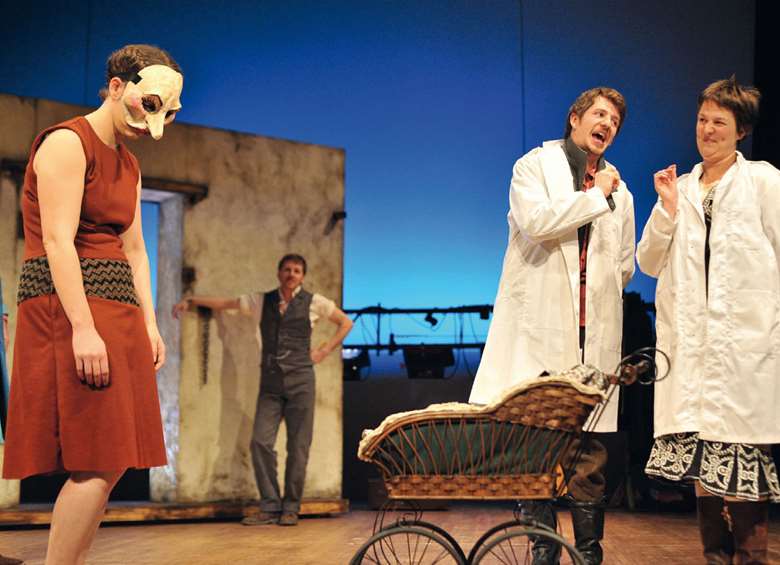Play for study: The Caucasian Chalk Circle
Zeena Rasheed
Tuesday, October 1, 2019
Each issue of D&T we bring you a teacher's guide to a play for study with your students, written by a fellow teacher. This issue, Zeena Rasheed explores The Caucasian Chalk Circle, a set text for WJEC/Eduqas at GCSE

GEORGE RIDDELL – SCOTTISH PHOTOGRAPHY CENTRE
An option for WJEC/Eduqas’ GCSE Component Three, The Caucasian Chalk Circleis a big-hearted and unusually happy play for Brecht. Grusha gets her man and her baby. It contains satirical, visual humour, and is chock-full of devices of Epic theatre. It's been performed by the great and the good, schools and youth companies, and references Bible stories and Chinese legends.
Context
The play is didactic and unashamedly lefty, with moral worth given to the collective. Brecht's juicy ability to cause trouble might also animate learners – get them to look into the attentions of the Un-American Activities committee in 1947, his split with celebrated actress Luise Rainer, and the problems with William Gaskill's fascinatingly radical 1962 RSC production (edited at the 11th hour by Peter Hall).
It is easy to over-theorise with Brecht, a trap Brecht himself arguably fell into. It's more than reasonable to admire his work, but not the man – despite the wars and traumas of his personal arc. We question his treatment of women, and might well ask where he questions the oppression and tyranny suffered behind the Iron Curtain post-1945.
Characteristics of the text
The structure is a classic play-within-a play, and ensemble and an ability to find humour are crucial as is a keen interest in the place of justice and truth in society. The fourth wall is broken, there are singers and archetypes, musicians and verse, and the clear political dynamic of a ‘lehrstuck’. The audience would ideally laugh and learn. The familiar becomes absurd, the judge is a buffoon, the poor female child-thief is the hero of the day, the rich are corrupt, the strange becomes familiar.
I recommend keeping ideas around characterisation strong and uncomplicated. The distancing effect is one where actors can multi-role, and represent characters, energetically and physically, with truth as storytellers. It is not becoming an alien, or emotionless acting with ranty shouting and placards. The acting must entertain and engage. It is a robust style – contemporary companies like Splendid and Kneehigh provide examples. There is an irreverence, a glee and a real connection with character, cast and audience. Watching a section of the National Theatre's Threepenny Opera helped me and my class ‘get’ this.
I find John Fuegi's quote helpful: ‘The key test always was: does it work on stage? If not, throw it out. If it does work, and if it conflicts with Theory, throw away Theory.’ (Directors in Perspective – Bfertolt Brecht – Chaos According to Plan).
Playing with gestus, using clowning, commedia and mime would all be beneficial in studying this text. Anything which encourages physical, ensemble storytelling will enable learners practically to do – and consider – Brecht's stylistic key features confidently.
This could involve shared storytelling, devising games where teams create mini-sections of the Circle with 6 props, one song and shared narration. I like actors trying lines in intuitive and contradictory ways. For example, ‘Look! There's a judge for you!’ could be tried reverentially, disrespectfully, or playfully. Using questions can unlock understanding in rehearsal.
The language is musical and poetic, often colloquial. Learners could write a chat they’ve had, rehearse as dialogue, then, in character, sing it. What happens? Do we see the narrative characteristics of the musical? The cabaret? The joke? The ballad? Does the audience re-engage, think, feel – and who do they empathise with? What are they angry about?
Brecht can read as wordy and worthy, so it can help to edit key sections to highlight the poetry, the delicious crudity, (have a look at the fake marriage-to-draft-dodger Yussup section), the wit of the tickle and the hammerblow of the slap.
The stage directions are a joy (in my Heinemann version) and encourage a visceral and visual humour and energy. Actors can play with these. For example, the pulling of the child can be done with a puppet, or without contact but with sound effects, maybe with the whole chorus as the distressed child's cries whilst Grusha struggles but the Wife asks for ear plugs. The section where the comic, openly venal Azdak sidesteps death to become judge, before again noose-dodging, has a wealth of creative opportunities for farce, slapstick and satire.
Space and stage
It would be advantageous to experiment with one section – perhaps the chalk circle scene. If one group attempted traverse, another end-on, another thrust and one in the round with ideas for set and props, lights and sound, students would be better cognitively prepared for staging and design questions. Which version was most visually powerful? Most immersive? Most comprehensible? As directors, what staging would create the intended effect that might entertain enough to ‘… galvanise the audience to challenge injustice in society…’? (Ben Hales: Splendid Style).
Links and resources:
-
Splendid's excellent Splendid Style is due a reprint
-
Brecht: A Practical Handbook by David Zoob (Nick Hern Books, 2018)
-
Theatre in Practice: A Student's Handbook by Nick O’Brien (Routledge, 2018)
-
www.sharedexperience.org.uk/media/education/the-caucasian-chalk-circle_edpack.pdf
-
http://ntlive.nationaltheatre.org.uk/productions/56691-thethreepenny-opera
-
YouTube: ‘An Introduction to Brechtian Theatre’.

